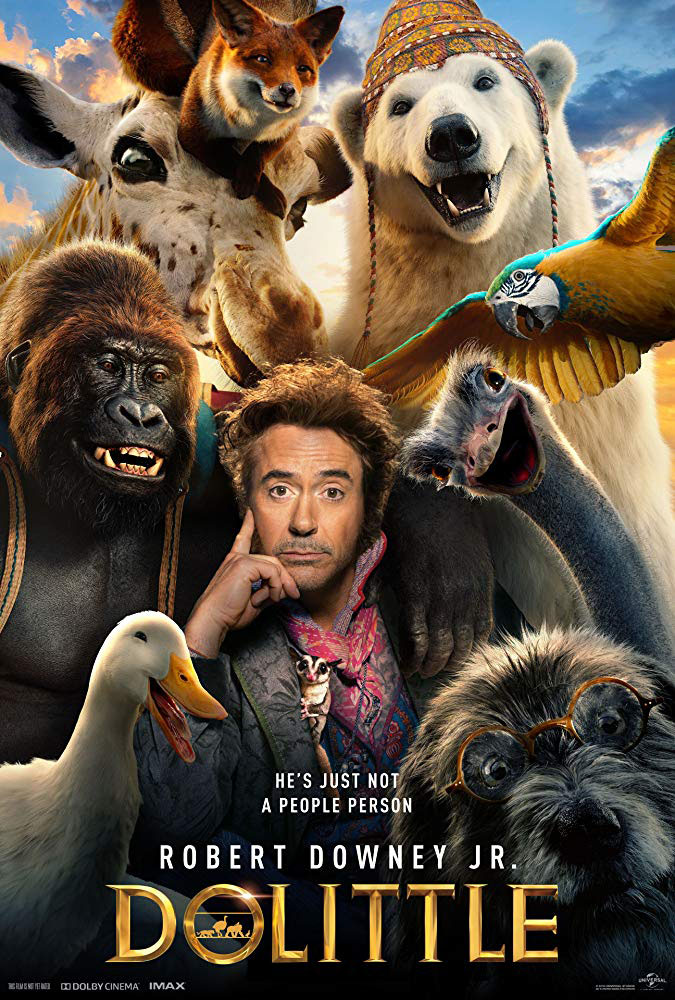
“Dolittle” is the third film iteration of a story inspired by characters from the 1920s children’s book. The 1960s had Rex Harrison’s musical version, the 1990s had Eddie Murphy’s hyper-comedic versions and we begin 2020 with Robert Downey Jr’s dramatically inert version. The familiar tale has deviated in focus, but its central idea has remained the same – it is a story of a veterinarian with the ability to talk to animals. There are a number of places to go from that central conceit, and this version, with four (!) credited writers, decides to take us to early Victorian era England as it abandons the unrepentant zaniness or silliness of the conceit for something that is immediately steeped in tragedy.
In this version, our famed doctor has retreated from all human contact to a life of isolation in his manor after the untimely death of his wife some years earlier. His dismal isolation, with only his collection of animals as company, is interrupted when two visitors pierce his seclusion. This timely coincidence is the first in a long line of issues that the film is unable to deal with. The coincidence that these two unconnected visitors arrive at the same time goes by with a bit of cinematic hand-waving, but as “Dolittle” goes on, we come to realise that every potential plot-point and development is met with the same kind of inexplicable, coincidental sloppiness that undermines any idea of dramatic coherence in the film.
The intriguing thing is that this is hardly the most indictable part of “Dolittle”. Sloppily handled coincidences (a dying Queen Victoria, a manor on the brink of being lost, a childhood schoolmate, etc, etc) are one thing but approached with sincerity of tone, and formal consistency “Dolittle” would be trite, at worst, and sweet, at best. The 1967 version of the tale, for example, though bloated, has an earnest charm that shines through even at the worst moments. The Murphy versions of the 90s have a goofy air that is consistent, throughout. But Downey Jr, an actor typically known for his ability to jostle with cinematic oddities to create a sense of charm on screen feels bizarrely leaden here. Much of the film, by design, centres on the way Dolittle interacts with his animal counterparts, except it’s an angle that feels immediately incongruous. The film is mixed in a way so that the voice-actors seem to be working at odds with the animals they’re meant to be voicing. It goes beyond the general oddity of having a range of (very often American) accents living in early Victorian England (it’s fantasy, so we’ll allow it), or even that the mouths of the animals never seem to be imitating what the characters are saying, but on a very basic mixing level the soundscape of the film seems removed from the visual work, creating an inexplicable sense that the filmmaking has no structural or spatial awareness. The result becomes confusing whenever there’s an extended scene centred on the animals, and it gets even more confusing when the human-to-human relations seem just as confusingly rendered. At its best, even a bad version of the film could present us with a chance to watch some technical animal splendour, but the photography here never delivers a careful interest in presenting any celebration of animals and instead gives us only dutiful shot-after-shot hurtling to the merciful end of it all.
“Dolittle” announces itself as an adventure comedy, yet the adventure is nascent and the comedy is tedious. The central adventure the team go on feels so devoid of real stakes, and that could be forgiven if the film was able to muster up enough goodwill for us to enjoy watching this intrepid gang of rescuers interact with each other – but no such luck. Instead, the 100 minutes drag on. The film’s idea of humour is best described by an exhausting sequence where an antagonising animal repeats to our hero, “Dolittle did a doo-doo.” Hardly comedic excellence, even if it is an accurate summation of the film.
A brief dig into the making of film reveals a mass of behind the scenes issues and drama – months of reshoots, and a director only in name. It helps to explain (some) of the inexplicable budgeting. But, even beyond the woeful tales of reshoots, nothing in “Dolittle” seems so argue for anything essential. The fact that poorly reviewed test-screenings necessitated countless reshoots and restructuring is intriguing if only because it’s hard to imagine that the version we are presented with here is a superior version of anything.
Devoid anything to cling to narratively, artistically or aesthetically, “Dolittle” leaves me with a mass of questions. What made Robert Downey Jr choose this as his first non-Tony Stark role in the last six years? What made the filmmakers opt for a Victorian setting for this film, which seems hardly informed by any sense of how British succession work, or by any genuine interest in considering how the Victorian era feels about animals or humans? What is the driving force behind this production? Its ethos? And, where did that 175 million USD budget go?
“Dolittle” is currently playing at Caribbean Cinemas Guyana and MovieTowne Guyana






